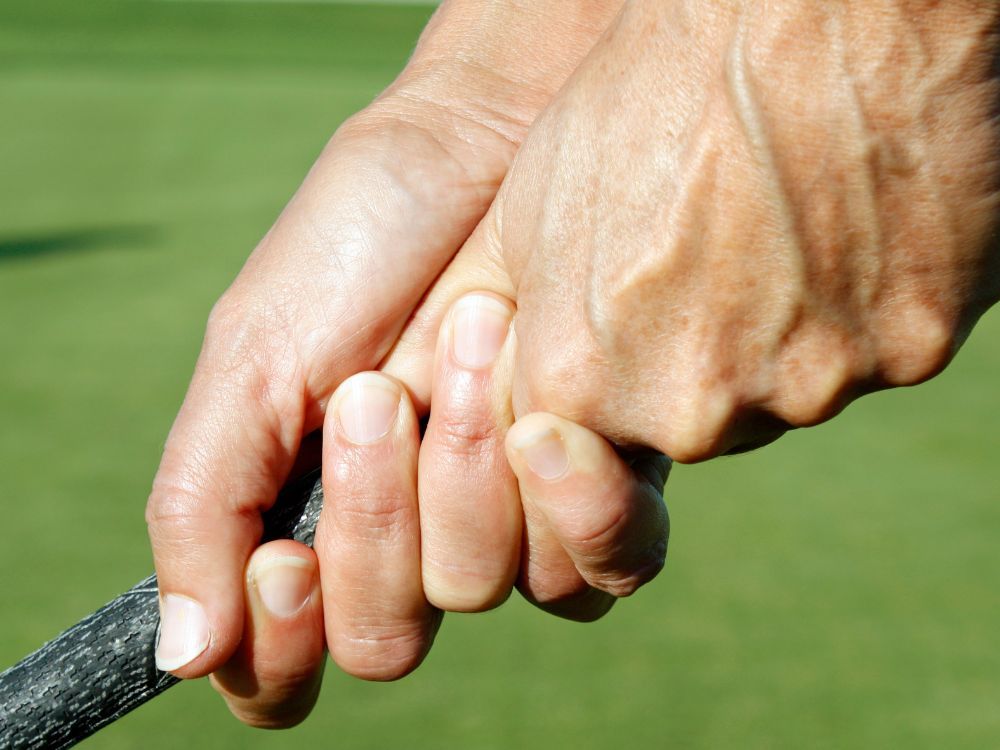Content Summary
Stance
Your stance is the foundation of your golf swing, affecting all aspects of your game. Having the correct stance can help you to maintain balance, posture, and agility throughout the swing, especially with tee shots .
Additionally, maintaining the correct stance can help to prevent you from swinging too hard and losing control of your club. When your stance is not properly set, it somehow makes you want to swing faster. Let’s explore the different elements of stance and how they can help you prevent over-swinging.
Set up with your feet shoulder-width apart
A good stance is the first step to keep from swinging too hard on your golf swing. Start by setting up with your feet shoulder-width apart and parallel to the target line.
This will help you maintain balance throughout the entire swing, which is important because a loss of balance during a golf swing can cause you to be extremely aggressive and overswing.
Your grip should also be firm but relaxed with just enough tension so that your arms do not move off the vertical plane while setting up and during the swing. A loose grip will prevent tension in your arms and shoulders, allowing you to maintain more control throughout your swing.
Next, you need to set up correctly with your backswing hinge at hip level making sure to complete your backswing to the top and when making your downswing you don’t pull down excessively on the club forcing a full arm extension.
This can limit rotation around your spine which could cause extreme acceleration through impact zone resulting in an overswing. Setup and ball position for full swing timing and rhythm are critical to the full swing, but equally important is your setup position.
The setup position is where you will get into rhythm with your backswing and downswing through body turn.
Make sure your weight is evenly distributed
When setting up your stance in golf, start by evenly distributing your weight on the balls of your feet. If you stand too far forward or far back, it can unbalance you and make it more difficult to stay in control when swinging.
You should also be sure to have a slight bend in your knees and keep them approximately shoulder-width apart throughout the swing.
If you’re too bent over or too upright during address, you won’t be able to maintain proper balance.
Your arms should hang relaxed from your shoulders and avoid locking your elbows – this will reduce power but will also help encourage a consistent tempo.
Place the club behind the ball at a 45-degree angle to ensure that the face is square at impact and the ball will fly off on its intended path.

Keep your head still
As a general rule, keep your head still throughout the swing, making sure that it doesn’t move back as you pull back and then quickly forward as you come through impact into follow through.
To control your golf swing and prevent excessive force, it is important to keep your head still as you swing. Keeping a stationary head through impact will help maintain balance and power throughout the hit.
When you practice, be sure to have a 'check point' somewhere on the ground along the direction of your hit that you can use to track the steadiness of your head throughout the entire swing back and forth.
Additionally, keeping your feet firmly planted on the ground and a slight flex in your knees will help increase stability throughout the strike. Understanding when you should begin shifting forces in each step of your golf swing can also help get more power out of each shot without sacrificing control.
Make sure to pay attention to when you're transferring weight from one side to another or how much pressure is being applied from hand to grip — timing each move correctly is key.
Finally, visualizing during practice can be helpful for increasing accuracy during match play: Visualize where you'd like ball contact so that when it comes time for an actual game, instead of over-swinging, you already have an image in mind ensuring more controlled strokes with every hit.
Grip
A proper grip is essential to avoid swinging too hard in golf. If you have a good grip, you will be able to maintain control and accuracy when swinging a golf club. It is important to make sure that your grip is comfortable and secure.
Using the proper grip will also help you to reduce tension in the arms, shoulders, and wrists. Understanding how to grip your golf club correctly is the first step in preventing yourself from swinging too hard.
Make sure your grip is relaxed
When gripping the club, your grip should be relaxed. This is important to ensure that you are controlling the club, rather than letting it control you.
A grip that is too tight will restrict movement and cause you to swing the club with an excess of force, negatively impacting accuracy and ball flight.
To ensure a relaxed grip, think of “holding on to a sparrow” so they cannot fly away but you are not squeezing them so tight that they cannot breath.
You should feel as though you could easily carry the bird around comfortably without concern. This feeling is essential for allowing a light but still effective grip on the golf club.
Be aware of the tension in your arms as well when gripping the golf club. Your shoulders should be level when addressing the ball and should remain as relaxed as possible throughout your swing while staying slightly engaged with one another so they can move naturally during every step of your backswing and downswing motions.
Finally, make sure that your hands do not move during any part of these motions; shifting grips during swings can lead to inconsistencies with contact between your clubface and the ball itself, resulting in inaccurate shots or wild hooks or slices to incorrect parts of the course.

Don't rush the downswing
Many golfers get to the top of their backswing and then want to rush the downswing and just demolish the ball. This throws your whole swing out of sequence and causes a ton of mishits, fat shots, hooks and slices.
When you get to the top, pause for a split second and let your lower body and hips unwind while dropping your hands and arms down (do not pull the club down) with the body rotation. Make sure you have enough club for the shot.
Golfers tend to use the club they hit on the golf range under perfect conditions with no obstacles. Your brain will tell you if it thinks you can get to the target so listen to it and use more club if you have to.
Make sure your hands are in the correct position
The correct hand positioning will help you maintain a steady, smooth motion as you make contact with the ball. To get the most out of your swing, here are some tips for positioning your hands:
● Make sure your palms are facing each other and enclose the club firmly but gently.
● Align your hands so every knuckle is in a straight line on both sides of the club.
● Angle the “V” shape between your thumb and index finger pointing at or slightly inside your right shoulder (for right-handers).
● Keep a light pressure through impact, allowing the clubhead to do its work as you hit through the ball naturally.
● Keep a relaxed grip and avoid clenching during the swing to ensure freedom and increase accuracy towards the target line.
Taking all of these elements into consideration when holding onto, gripping and swinging with a golf club will leave you feeling steady in form yet confident in power throughout each shot.
Swing
Many golfers feel like they need to swing hard to generate a powerful swing but this can cause inaccuracies. You want club head speed but done right. Thankfully, there are a few techniques you can use to help prevent this common mistake.
Keep your arms and hands engaged
It is important to keep both hands on the grip during the backswing. While some golfers may feel more natural letting their non-dominant hand relax, this increases the risk for an out-of-control swing with too much wrist action and can lead to inconsistencies in shot accuracy.
Concentrate on keeping both hands locked on your grip and you’ll be able to ease into a controlled backswing with better accuracy.
Take a slow backswing
One of the best ways to prevent swinging too hard in golf is by taking a slow backswing. Taking a slow backswing helps you maintain control, allowing you to pick up the club with proper technique and rhythm.
It enables you to practice good posture and balance which will turn into improved ball striking. Additionally, it helps your muscles become accustomed to the same arc of movement which leads to more consistent shots and improved accuracy on the golf course.
Start by focusing on a slow yet steady backswing no more than waist high in height. This should give your muscles enough time to process the direction of the club's face and its proximity to your body so that when it comes time to swing down, you are able to more accurately hit an intended target line without going off course or making contact that's less than desirable.
Make sure you keep your arms close together throughout the motion as this will help you generate power in addition to accuracy and also reduce strain on both wrists and elbows occurring from swinging too hard.
Furthermore, strive for fluidity with each practice session and tempo drills such as counting out loud during each practice repetition can assist tremendously in developing proper rhythm and consistency.
As your technique improves over time, gradually increase how long it takes for your body's motion from takeaway until impact by an extra second or two; this will help further build muscle memory into precision play that shows on the scoresheet when playing out on the golf course.
Make sure your body is in the correct position
If possible, practice regularly and take lessons from a professional instructor to help hone both your technical and mental swings.
Make sure you are in sync with yourself when it comes to how much force to apply to each of your shots in order to limit over swinging. As always take note of what has worked for you in practice so you can replicate those same results when you actually play golf.
Finally always get feedback from a qualified coach whenever possible and use it as an opportunity to become better and make sure you have the proper golf clubs!
Follow Through
Following through with your golf swing is an essential part of a successful shot. Proper follow through helps you control the clubhead’s path and speed, delivering consistent results. However, too much follow through can cause you to swing too hard, reducing accuracy.
Make sure your arms and wrists stay in the same position
The key to making sure your arms and wrists stay in the same position throughout your swing is to practice the correct technique regularly. This will help you understand how to keep your arms and wrists in line from start to finish.
When you start your backswing, try using a style called “one-piece take-away”. This style allows you to easily maintain the proper one-piece arm position without introducing any unwanted movement.
On the downswing, avoid reversing the motion of your hands and arms by starting with a deliberate wrist uncocking movement, let gravity take control of the motion caused by inertia.
By maintaining a constant arm position during the swing, you prevent yourself from over swinging or getting out of balance. Therefore, it is essential that you practice this technique regularly until it becomes second nature to you.
Additionally, it is important that you remain aware throughout your entire swing so that you can detect any faulty movements before they are overly exaggerated and cause more harm than good.
Keep your body in the same position as you finish the swing
Keeping your body in a stable position as you finish will allow you to stop at the same point of your swing every time.
This is important because it prevents overextension, which can cause inaccuracy, and it allows you to find a consistent tempo in your swing. A good rule of thumb is to keep the flow of your golf swing relaxed and smooth from start to finish.
If all parts of your body are connected and remain in their original positions throughout your golf swing, then this will help keep you from swinging too hard at impact.
Additionally, it can be beneficial to practice with a slow-motion swing in order to truly feel this connection between all parts of your body before attempting an average speed or fast-paced full golf shot.
Conclusion
Swinging too hard in golf can have a negative effect on your game. We all want to hit the golf ball hard. To prevent this from happening, focus on proper technique and form, stay relaxed, use visualization techniques to visualize the shot you want to take, and practice consistently this will make your golf swing smoother.
Additionally, be conscious of your grip strength and take short practice swings to get a feel for the shot ahead of time. With these steps in place, you can prevent yourself from swinging too hard and start hitting better golf shots.






